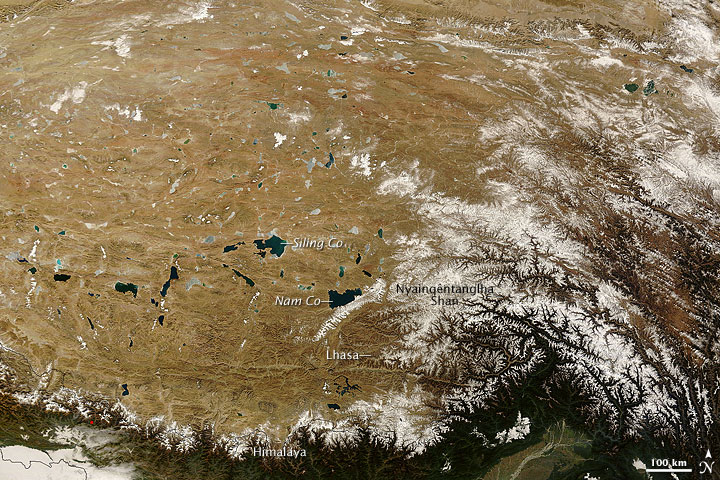31 July 2019
Decades-old pollutants melting out of Himalayan glaciers
Posted by larryohanlon
By Mary Caperton Morton
Melting Himalayan glaciers are releasing decades of accumulated pollutants into downstream ecosystems, according to a new study.
The new research in AGU’s Journal of Geophysical Research: Atmospheres finds chemicals used in pesticides that have been accumulating in glaciers and ice sheets around the world since the 1940s are being released as Himalayan glaciers melt as a result of climate change.
These pollutants are winding up in Himalayan lakes, potentially impacting aquatic life and bioaccumulating in fish at levels that may be toxic for human consumption.
The new study shows that even the most remote areas of the planet can be repositories for pollutants and sheds light on how pollutants travel around the globe, according to the study’s authors.
The Himalayan glaciers contain even higher levels of atmospheric pollutants than glaciers in other parts of the world “because of their proximity to south Asian countries that are some of the most polluted regions of the world,” said Xiaoping Wang, a geochemist at the Chinese Academy of Sciences in Beijing and an author on the new study.

The high mountain glaciers of the Tibetan Plateau feed thousands of alpine lakes that form the headwaters of many of Asia’s major rivers. Credit: NASA image courtesy Jeff Schmaltz, MODIS Rapid Response Team, Goddard Space Flight Center.
For pollutants, there is no away
Pollutants can travel long distances through the atmosphere on dust particles and water molecules. Previous studies have shown that Arctic and Antarctic ice sheets contain high levels of pollutants that traveled thousands of kilometers before dropping onto ice and being incorporated into glaciers. This phenomenon of high levels of contamination far from sources of pollution, known as the Arctic paradox, is also seen in high mountain glaciers like those in the Himalaya.
The Nam Co Basin, on the central Tibetan Plateau in the Himalaya between the Gangdise-Nyainqȇntanglha mountains to the north and the Nyainqȇntanglha range to the south, is home to more than 300 glaciers that covered nearly 200 square kilometers in 2010. But the ice is melting: Between 1999 and 2015, the total volume of ice in the Nam Co Basin decreased by nearly 20 percent.
Due to global warming, Himalayan glaciers are melting at an unprecedented rate, releasing decades of accumulated pollutants into ecosystems downstream, Wang said. To better understand this cycle, Wang and colleagues measured the concentrations of a class of chemicals used in pesticides called perfluoroalkyl acids (PFAAs) in glacial ice and snow, meltwater runoff, rain and lake water in Nam Co Basin.
By testing ice, snow and water samples collected in the Nam Co Basin, Wang and colleagues found glaciers in the region are releasing around 1,342 milligrams of PFAAs per day into Lake Nam Co. They detected levels as high as 2,171 picograms per liter in the lake. Under these conditions, the estimated total annual input of PFAAs into Lake Nam Co is approximately 1.81 kilograms per year.
“In general, the results are comparable to previous studies on lakes in polar regions,” the team wrote.
That kind of influx of PFAAs can have an impact on aquatic life in the lake and downstream, said Kimberley Miner, a geochemist and climate scientist at the University of Maine in Orono who was not involved in the new study.
PFAAs are known for having a very long lifespan. The chemicals don’t regularly biodegrade and are readily passed through organisms and ecosystems, while being continually concentrated through various biogeochemical processes, Miner said. The new study did not include a toxicity risk assessment of these levels on aquatic life, but previous studies suggest that eating fish caught in the lake could be detrimental to human health, she says.
“The bioaccumulation potential for these chemicals is extraordinary,” Miner said.
First, microorganisms and insects take up molecules into their tissues, then fish and other predators eat them, passing the contaminants up the food web in higher and higher concentrations.
“This [Nam Co Basin] water also feeds directly into the water resources in India,” she added.
The study adds important data to the bigger picture of how pollutants cycle around the globe, Miner said. Similar studies have been conducted at the poles and in Europe, but not as much is known about pollutants in the Himalaya. Each mountain range has its own characteristics that influence how chemicals move through the environment, she added.
“The Earth is a closed system. Everything released on the Earth, stays somewhere on the Earth,” Miner said.
Mary Caperton Morton is a freelance science writer.










 GeoSpace is a blog on Earth and space science, managed by AGU’s Public Information staff. The blog features posts by AGU writers and guest contributors on all sorts of relevant science topics, but with a focus on new research and geo and space sciences-related stories that are currently in the news.
GeoSpace is a blog on Earth and space science, managed by AGU’s Public Information staff. The blog features posts by AGU writers and guest contributors on all sorts of relevant science topics, but with a focus on new research and geo and space sciences-related stories that are currently in the news.